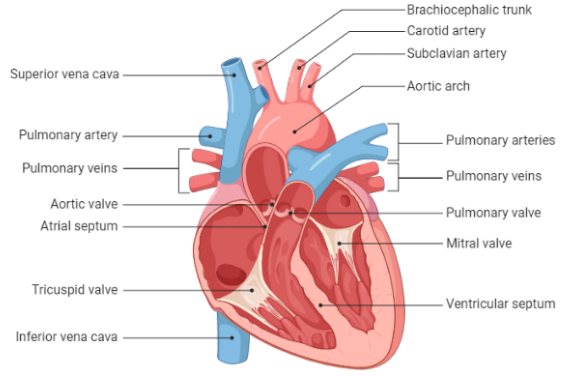
Answer
410.7k+ views
Hint: The heart is a hollow, muscular organ that transports oxygenated blood throughout the body and deoxygenated blood to the lungs. This important circulatory framework structure consists of these four chambers. One chamber receives blood with waste (from the body), and another chamber pumps it out toward the lungs, where the waste is expelled.
Complete answer:
The four chambers are separated in the heart. The two upper rooms are referred to as the atria. A mass of tissue called the atrial septum isolates the right chamber and left chamber. The two lower chambers are called ventricles and are separated by the ventricular septum into the right and left ventricles. They have thicker walls and blood is pumped to the lungs and body are present in the ventricles.
The heart is partitioned into four chambers; the two upper chambers are the left chamber (auricle) and right chamber (auricle), while the two lower chambers are the left ventricle and right ventricle.
The left chamber gets deoxygenated blood from the body by means of the veins (the inferior and superior venae cavae), while the right chamber gets oxygenated blood from the lungs through the respiratory veins.

Additional Information:
There are three layers of the heart. Epicardium is the outermost component (or instinctive pericardium). The epicardium protects the heart by covering it, folding over the foundations of the exceptional veins, and following the heart septum to a protective sac. Myocardium is the middle layer. The heart's pumping operation is controlled by this sturdy muscle tissue. The endocardium, the heart's innermost layer, lines the heart's inner side.
Note:
The heart's muscle wall helps dilate and contract. Every contraction and rest are a heartbeat. Ventricular contractions, known as systole, force blood out of the heart by aortic valves and pulmonary valves. When blood flows from the atrium to fill the ventricles, diastole occurs.
Complete answer:
The four chambers are separated in the heart. The two upper rooms are referred to as the atria. A mass of tissue called the atrial septum isolates the right chamber and left chamber. The two lower chambers are called ventricles and are separated by the ventricular septum into the right and left ventricles. They have thicker walls and blood is pumped to the lungs and body are present in the ventricles.
The heart is partitioned into four chambers; the two upper chambers are the left chamber (auricle) and right chamber (auricle), while the two lower chambers are the left ventricle and right ventricle.
The left chamber gets deoxygenated blood from the body by means of the veins (the inferior and superior venae cavae), while the right chamber gets oxygenated blood from the lungs through the respiratory veins.

Additional Information:
There are three layers of the heart. Epicardium is the outermost component (or instinctive pericardium). The epicardium protects the heart by covering it, folding over the foundations of the exceptional veins, and following the heart septum to a protective sac. Myocardium is the middle layer. The heart's pumping operation is controlled by this sturdy muscle tissue. The endocardium, the heart's innermost layer, lines the heart's inner side.
Note:
The heart's muscle wall helps dilate and contract. Every contraction and rest are a heartbeat. Ventricular contractions, known as systole, force blood out of the heart by aortic valves and pulmonary valves. When blood flows from the atrium to fill the ventricles, diastole occurs.
Recently Updated Pages
Write the IUPAC name of the given compound class 11 chemistry CBSE

Write the IUPAC name of the given compound class 11 chemistry CBSE

Write the IUPAC name of the given compound class 11 chemistry CBSE

Write the IUPAC name of the given compound class 11 chemistry CBSE

Write the IUPAC name of the given compound class 11 chemistry CBSE

Write the IUPAC name of the given compound class 11 chemistry CBSE

Trending doubts
Fill the blanks with the suitable prepositions 1 The class 9 english CBSE

Which are the Top 10 Largest Countries of the World?

How do you graph the function fx 4x class 9 maths CBSE

Distinguish between the following Ferrous and nonferrous class 9 social science CBSE

The term ISWM refers to A Integrated Solid Waste Machine class 10 social science CBSE

The Equation xxx + 2 is Satisfied when x is Equal to Class 10 Maths

Difference between Prokaryotic cell and Eukaryotic class 11 biology CBSE

Which is the longest day and shortest night in the class 11 sst CBSE

In a democracy the final decisionmaking power rests class 11 social science CBSE




